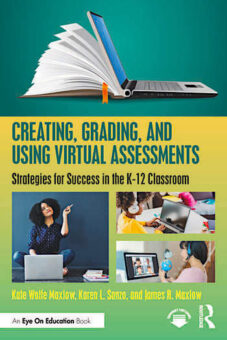A Guide to Expanding Virtual Teaching Skills
Creating, Grading, and Using Virtual Assessments: Strategies for Success in the K-12 Classroom
By Kate Wolfe Maxlow, Karen L. Sanzo, and James R. Maxlow
(Routledge/Eye On Education, 2021 – Learn more)
Reviewed by Theresa Wood

Until then our students had regular, though not daily, opportunities to use computers. Our school had several labs and carts that we could sign our classes up for – but we did not have enough computers on hand for one-to-one access for students.
Teachers had attended workshops and training sessions for years to build our technology skills, but without daily practice those skills had grown stiff with little regular use.
With the coming of Covid, suddenly we realized how patchwork those skills really were. Our students likely felt the same way. While their technology skills were a bit more up to date, they had limited practice in using technology tools to learn.
A New Hunger

This hunger has not abated for me, even though we returned to something akin to “normal” this past school year. Our district now provides one-to-one technology resources for students, and we are continuing to use our online learning management system for the foreseeable future.
While the basic digital skills and fluency are now in place, the question becomes how to move forward and use these skills and this technology effectively.
The Post-March 2020 Classroom
This recent history is the main reason that Creating, Grading, and Using Virtual Assessments: Strategies for Success in the K-12 Classroom first caught my attention. But it’s the authors’ opening sentence that hooked me: “The way we understand education – how to teach, assess, and engage students – has demonstrably and irrevocably changed since March 2020.”
I knew from the start that these authors were colleagues and understood what the past two years have been like for us educators in the classroom. This is a new normal for all of us, one in which technology will be forever embedded.
Accessible, Focused and Well-organized
The accessible, mentoring tone continues throughout this focused and well-organized book. The first chapter reviews traditional classwork and homework practices to show how technology can be leveraged to provide more authentic assessment of student understanding. The remaining chapters center on using discussion, performance, and projects as assessments, with each chapter structured similarly – beginning with creating, then using, and ending with grading each type of assessment.
Case studies in each chapter use the formative assessment protocol (identify-plan-apply-assess-refine) to show how the assessment practice (traditional, discussions, performance, projects) can be implemented in real-world contexts. An additional section is included in each chapter to guide book studies or professional learning communities in their study of classroom technology. Finally, each chapter concludes with a review of tools available for teachers to use beyond their learning management systems.
For such a small book, at 155 pages, Creating, Grading, and Using Virtual Assessments packs in a ton of information, much of which is valuable beyond the discussion of how to incorporate technology meaningfully into the classroom. The section on planning incorporates learning intentions, success criteria, cognitive engagement, SAMR level (whether technology will substitute, augment, modify, or redefine traditional methods) and a grading plan and helps to clarify up front the purpose of both assessment and the use of technology. This planning frame and other resources are available for free at the publisher’s website.
The authors’ comments on creating assessments, grading, and using rubrics were also illuminating outside of the discussion on technology as they apply to good teaching practices. I think there is a tendency to sometimes forget those when shifting to an online environment.
The inclusion of discussions, performances, and projects as assessments is also helpful as these are activities I often assigned in traditional classrooms, but when online I was unsure about how to grade them.
For All Grade Levels and Content Areas
Ultimately, this book delivers on the promise of its title. The authors included all grade levels in the advertised grade band (K-12) and all content areas in their examples – something that makes this book not just relevant for a wide audience but can help facilitate faculty conversations across teaching teams representing different content areas.
The authors are teachers who work with teachers, and they address concerns of importance to us – cheating, differentiation, and participation – without judgment through realistic examples. As they say in the preface, they “designed this book so that you can pick it up and start reading from any chapter,” and this is absolutely true. This is a book I will be referring to again and again as I plan and teach throughout the year.
Theresa Wood, M.Ed. is starting her twenty-fifth year teaching in elementary and middle school classrooms. She currently teaches middle school English/Language Arts, where she has worked for seventeen years, and enjoys sharing her enthusiasm for literature and language. She is an unapologetic bibliophile, has served as department chair, team leader, a mentor for new teachers, and is a graduate of the National Writing Project.






























